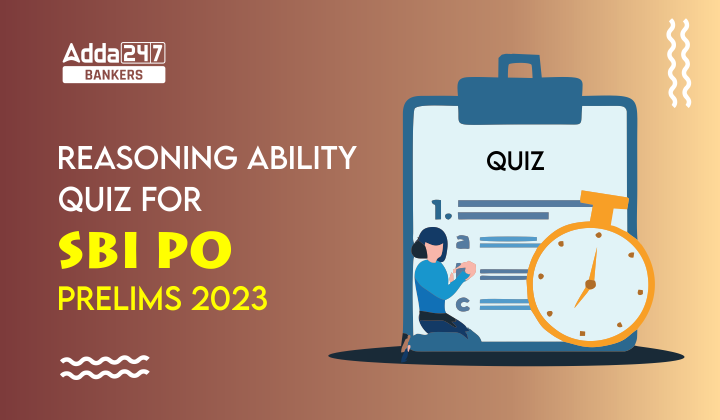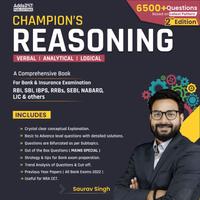Directions (1-5): Study the following information carefully and answer the question given below.
Eight persons are sitting in a straight line and all are facing north direction. Each of them prepares for different competitive exam. S prepares for Bank and sits third to the right of Q. R sits immediate left of V who prepares for SSC. The one who prepares for AFCAT sits second to the left of Q. The one who prepares for UPSC sits third to the left of V. W prepares for NDA and he is an immediate neighbour of U who does not prepare for AFCAT. V is not an immediate neighbour of S. Persons who prepare for CDS and UPSC sit together. T sits third to the left of the one who prepares for UGC NET. W is not an immediate neighbour of S. P does not prepare for CTET.
Q1. Who among the following person prepare for CTET exam?
(a) T
(b) R
(c) W
(d) U
(e) None of these
Q2. Who among the following person sits third to the right V?
(a) The one who prepares for AFCAT
(b) The one who prepares for CTET
(c) S
(d) P
(e) None of these
Q3. What is the position of Q with respect to T?
(a) Third to the right
(b) Immediate Left
(c) Second to the right
(d) Immediate Right
(e) None of these
Q4. Which of the following statement is not true about U?
(a) U prepares for CTET
(b) U sits immediate right of S
(c) U does not prepare for UPSC
(d) Only two persons sit between U and the one who prepares for SSC
(e) Both (B) and (D)
Q5. Who among the following sits immediate right of the one who prepares for UGC NET?
(a) V
(b) U
(c) W
(d) P
(e) None of these
Directions (6-10): In these questions, relationship between different elements is shown in the statements. The statements are followed by conclusions. Study the conclusions based on the given statements and select the appropriate answer:
Q6. Statements: G>H≤A=W≥U>O>D>C
Conclusion I: H<W
II: A>D
(a) If only conclusion I follows.
(b) If only conclusion II follows.
(c) If either conclusion I or II follows
(d) If neither conclusion I nor II follows.
(e) If both conclusions I and II follow.
Q7. Statements: J>W=X>I<P=D>L<F≤R
Conclusion I: X=L
II: F>P
(a) If only conclusion I follows.
(b) If only conclusion II follows.
(c) If either conclusion I or II follows
(d) If neither conclusion I nor II follows.
(e) If both conclusions I and II follow.
Q8. Statements: W≤E≤U>C<J≤D<L=S≤I
Conclusion I: C<S
II: U<D
(a) If only conclusion I follows.
(b) If only conclusion II follows.
(c) If either conclusion I or II follows
(d) If neither conclusion I nor II follows.
(e) If both conclusions I and II follow.
Q9. Statements: X≤W=S>D=M>K>O≤P≤L
Conclusion I: S≤O
II: S>O
(a) If only conclusion I follows.
(b) If only conclusion II follows.
(c) If either conclusion I or II follows
(d) If neither conclusion I nor II follows.
(e) If both conclusions I and II follow.
Q10. Statements: Q≤H=X>M≤O<P<L=D>H
Conclusion I: D>M
II: X>L
(a) If only conclusion I follows.
(b) If only conclusion II follows.
(c) If either conclusion I or II follows
(d) If neither conclusion I nor II follows.
(e) If both conclusions I and II follow.
Solutions
Solution (1-5)

S1. Ans. (d)
S2. Ans. (b)
S3. Ans. (a)
S4. Ans. (b)
S5. Ans. (c)
S6. Ans. (b)
Sol. I: H<W (false)
II: A>D(True)
S7. Ans. (d)
Sol. I: X=L (False)
II: F>P(False)
S8. Ans. (a)
Sol. I: C<S(True)
II: U<D(False)
S9. Ans. (b)
Sol. I: S≤O (False)
II: S>O(True)
S10. Ans. (a)
Sol. I: D>M(True)
II: X>L (False)





 GA Capsule for SBI Clerk Mains 2025, Dow...
GA Capsule for SBI Clerk Mains 2025, Dow...
 The Hindu Review October 2022: Download ...
The Hindu Review October 2022: Download ...
 World Malaria Day 2025
World Malaria Day 2025




